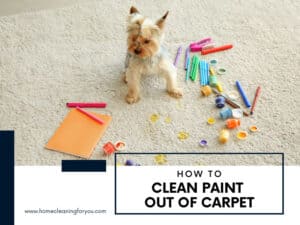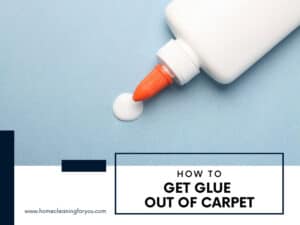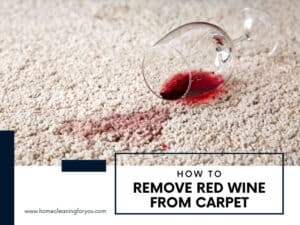22 Simple DIY Carpet Cleaners That Work Perfectly
Homemade carpet cleaners are becoming more and more popular. They are cheap to make, flexible to use, and are just as effective as other commercial products on the market. What’s not to love?
That said, don’t miss out on these fantastic cleaning formulas. Whether you are facing minor drink spills or tough stains left by blood or grease, they can always help you out. Scroll down and be amazed!

Homemade Carpet Cleaners To Keep Your Space Spotless
To most people, a carpet is nothing but just a floor decoration. They overlook the importance of maintaining its curb appeal, and over time, the carpet is no longer an ideal spot to roll over when the winter season arrives.
Without regular maintenance, a carpet will soon be defiled with dirt, pet waste, food crumbs, and other harmful microorganisms. This is not only unpleasant to the eye but also puts your health at great risk. That said, cleaning carpets is a must, and I’ll show you where to begin.

Chemical-Free Homemade Carpet Cleaning Solutions You Must Try
If your carpet is made from delicate materials like wool or silk, skip the chemicals. They can be somewhat invasive and even ruin your carpet entirely if you go overboard. The following section will show you that it’s feasible to clean with vinegar, salt, and many more.
1. Vinegar (For Most Stains)
Vinegar is a no-brainer when your carpet gets dirty for whatsoever reason. It is prized not only for being cheap and accessible but also for its ability to remove all sorts of odors, from smoke, pets to cooking.
For the best result, you are recommended to use white vinegar, which contains acetic acid. This cleaning agent can deal with stains, cut through grease, combat microorganisms, and neutralize foul odors. What’s not to love?

Ingredients
- White vinegar
- Water/salt/borax/cornstarch/detergent (depending on the stains you have)
How To Use
Step 1: Mix one part white vinegar with two parts water if you have a synthetic carpet. For natural fiber carpets, the ratio will be 1:1.
Depending on the stain you are dealing with, you can mix vinegar with other ingredients:
- General stains: 1 cup white vinegar + 2 cups water (synthetic carpets) or 1/4 cup white vinegar + 1/4 cup water (natural fiber carpets)
- Light stains: 1/2 cup white vinegar + 2 tablespoons salt
- Large or dark stains: 1/2 cup white vinegar + 2 tablespoons salt + 2 tablespoons borax
- Tough stains: 1 tablespoon vinegar + 1 tablespoon cornstarch
- Spilled paint: 1 1/2 teaspoons vinegar + 1 1/2 teaspoons detergent + 2 cups water
- Coffee/tea stains: 1 tablespoon vinegar + 1 tablespoon water
- Fruit/fruit juice stains: 1 1/2 tablespoon vinegar + 1 tablespoon detergent + 2 cups water
Step 2: Add the solution to a spray bottle, then spray generously on the stain. Alternatively, apply the solution to the carpet with a cloth rag or towel. If you use cornstarch, vacuum the remaining starch afterward.
Step 3: Allow your carpet to dry.
2. Salt (For Most Stains)
Salt is commonly used in the kitchen, but not many people know that it also functions as a carpet cleaner. Just a pinch of salt and your carpet’s curb appeal will be enhanced greatly. Still, it is not something you should use during colder months, and here’s why.
When mixed up with snow or water, salt can leave somewhat stubborn white stains on the carpet. Additionally, it is not suitable for carpets made from delicate materials like silk as it can be gently abrasive, mainly when you apply it using a hard brush.

Ingredients
- Salt
- Cold water
- Rubbing alcohol (optional)
How To Use
Step 1: If your carpet has recently suffered from water damage, blot the stains dry using a cloth rag or towel.
Step 2: Sprinkle some salt on the stains.
Step 3: Pour cold water all over the stains, allowing the salt to do the cleaning work for you. If you wish to speed up the result, you can scrub the stains gently with a brush. With greasy stains, mix 1 part salt with 4 parts rubbing alcohol and proceed similarly.
Step 4: Let it sit for a few minutes before rinsing the stains with cold water. Allow the carpet to dry.
Note: This method works best on colored carpets.
3. Vinegar And Salt (For Most Stains)
What happens when vinegar and salt join hands? You have a remedy for stains left by your kids and pets, whether they are urine, crayons, or drink spillage. For an extra fragrant result, add some drops of essential oil to this solution. It’s an instant mood-booster!
Ingredients
- White vinegar
- Salt
- Water
- Essential oil
How To Use
Step 1: Like the first method, you will mix water with white vinegar in a 2:1 ratio, followed by 2 teaspoons of salt.
Step 2: Next, bring in about 10-15 drops of your favorite essential oil and mix well.
Step 3: Transfer the solution to a spray bottle and give the stains some spritzes. For tougher stains, don’t hesitate to bring in a soft brush. Gently scrub back and forth until the stains start to come off.
Step 4: Finally, rinse the solution with water.
4. Baking Soda (For Most Stains)
You already know baking soda as a leavening agent for delicious baked treats, but that’s not all. This magical powder is greatly valued for its ability to clean kitchen appliances, bathroom fixtures, silver utensils, and even fruits.

Ingredients
- Baking soda
- Water
How To Use
Step 1: Dab the stain with a cloth. Avoid rubbing, or the stain will smear.
Step 2: Sprinkle baking soda so that it fully covers the stain. Let it sit for a few hours.
Step 3: Remove the baking soda paste by running the vacuum. Make sure that your vacuum comes with a HEPA filter that can suck up tiny particles without malfunctioning.
5. Vinegar And Baking Soda (For Most Stains)
Even the most stubborn stains have to concede when vinegar and baking soda team up. If you are having difficulties dealing with grease, you will be glad to know that these two guys can help you out with minimal effort.
When they are combined, a chemical reaction will occur and release a gas known as carbon dioxide. Indeed, this gas is non-toxic, so it’s completely fine if you notice the mixture bubbles or makes a fizzling sound. (1)
Ingredients
- White vinegar
- Baking soda
- Water (optional)
How To Use
Step 1: Pour white vinegar (straight or diluted with equal parts of water) all over the stain. It should be slightly dampened, not soaking wet.
Step 2: Bring in a sprinkling of baking soda. As mentioned, you will see the mixture foam up, which means they are working together to remove the stains. While vinegar helps soften the grease, baking soda steadily lifts the stain and deodorizes the area at once.
Step 3: Check to see if the stain is gone. If it is, vacuum the remaining baking soda. Let your carpet air dry.
Keep your carpet spotless with baking soda and white vinegar. Watch this video to know:
6. Salt And Baking Soda (For Most Stains)
Should the previous option fail or not bring expected results, try replacing vinegar with a little salt. Like baking soda, salt can easily break down the protein chains in grease, so be certain that it will do the trick this time.
Ingredients
- Baking soda
- Salt
How To Use
Step 1: Combine equal portions of baking soda and salt.
Step 2: Scatter the powdery mixture over the greasy stains on your carpet. Then, scrub the stains lightly and let them do the rest of the job. Leave them on for about 4-5 hours.
Step 3: Subsequently, run the vacuum to suck up the mixture. Easy-peasy!
7. Cornstarch And Milk (For Greasy Stains)
Greasy stains are a pain in the neck, and it’s even worse when they sit on your carpet. That said, the treatment is surprisingly straightforward. All you need is some cornstarch and milk, which are readily available in your kitchen.

Ingredients
- Cornstarch
- Milk
How To Use
Step 1: Mix an adequate amount of cornstarch with milk to create a paste.
Step 2: Spread the paste evenly on the stain.
Step 3: After a few hours, check whether the grease has lifted. If it has, vacuum the residue.
8. Club Soda (For Pet Stains Or Drink Spills)
Although club soda is nothing but plain water with dissolved carbon dioxide, sometimes salt, it is super-efficient against different stains, whether red wine or pet waste. Keep in mind that flavored products are not recommended as they can stain the fibers.
How To Use
Pour club soda directly on the stain, then mop up the excess liquid with a cloth rag. Repeat the process if needed.
9. Beer (For Drink Spills)
Apart from being a social drink at family gatherings and social events, beer can also treat many beverage spills. Like soda, you just need a splash of beer (cheap stuff works fine) on the stain with a few rubbing motions.

How To Use
The instructions for using beer as stain removal are the same as club soda.
Chemical Stain Cleaners That Bring The Glow Back On Your Carpet
If natural remedies fail your expectations, it’s time to step up your cleaning game with these chemical solutions. Of course, success is only guaranteed so long as you take preventative measures. From mild detergent to ammonia and WD-40, what’s your pick?
10. Detergent (For Most Stains)
Detergent does more than just clean your laundry. It contains surfactants, which facilitate the mixing between water and other substances. In plain English, it penetrates the stain and gradually lifts the particles from the fibers.
Another advantage of using detergent is that it can team up with other products like vinegar or baking soda to create a more robust solution but overall not too toxic. Keep this caveat in mind: some detergents contain bleach, which must not be used at all costs.

Ingredients
- Dishwashing detergent
- Water
How To Use
Step 1: Mix 1/4 teaspoon (for synthetic carpets) or a teaspoon (for natural fiber carpets) of detergent with a cup of warm water. Stir to distribute evenly.
Step 2: Work the paste into the stained fibers with a soft-bristled brush. Finish the procedure with a thorough rinse, or the residue will capture dirt and other particles.
Note: If the detergent is too concentrated, dilute with another cup of water.
11. Window Cleaner (For Most Stains)
Despite the name, this household product’s applications don’t just stop as windows. You will find a window cleaner a perfect substitute when laundry detergent is nowhere to be found. It can clean most general stains and is safe to use on a wide range of materials.

Ingredients
- Window cleaner
- Water
How To Use
Step 1: Use equal amounts of window cleaner and water to create a mild cleaning solution.
Step 2: Fill a spray bottle with the solution and mist the stain. Wipe it off with a cloth rag.
12. Ammonia (For Most Stubborn Stains)
With persistent or stuck-in stains, you will need to employ something more potent. Ammonia is a no-brainer in this situation: it can vanquish some of the most difficult stains, from tomato sauce, blood to hot cocoa.
Still, not many people have a soft spot for ammonia, particularly because of the putrid odor it gives off, which can attract your pets to urinate. Therefore, keep a close watch on your pet if it ever comes near the ammonia-treated area after cleaning.
Ingredients
- Clear ammonia
- Water
How To Use
Step 1: Dilute 1 tablespoon of clear ammonia with 1/2 cup of warm water.
Step 2: Dunk a washcloth into the solution and blot the stain gently.
Step 3: Once the stain is no longer noticeable, rinse and blot dry.
13. Hydrogen Peroxide (For Most Stubborn Stains)
Hydrogen peroxide has long been known for treating different wounds, but recently, it has made its debut in the cleaning scene. Besides its impressive cleaning properties, it is also used as a disinfectant to combat mold, mildew, and other microorganisms.
Bear this caveat in mind: you must never use hydrogen peroxide with a concentration higher than 6%, or you will risk ruining the whole carpet. Thus, it’s your safest bet to do a patch test in advance if you decide to go with this liquid.
Ingredients
- 3% hydrogen peroxide
- Cream of tartar or non-gel toothpaste
- Water
- Essential oil (preferably lemon)
How To Use
Step 1: Create a hydrogen peroxide solution using one of the formulas below:
- Mix 1 tablespoon of hydrogen peroxide with a dab of cream tartar or non-gel toothpaste
- If you prefer something stronger, mix 4 tablespoons of hydrogen peroxide with 1/2 cup of water, in addition to 5 drops of essential oil.
Step 2: Apply the solution to the stain with a cloth rag. Once done, rinse and let dry.
Give your carpet a good wiping with hydrogen peroxide. Watch this video to know:
14. Borax (For Most Stains)
Borax, or sodium borate, is the new baking soda. It was first discovered in Tibet and became common to the public in the late 19th century. (2) Overall, borax is a safe cleaning agent, but it’s well-advised to do a spot test to prevent further damage to your carpet.
How To Use
Step 1: Saturate the stain with a little water. Then, bring in a small amount of borax and rub gently. For a more successful outcome, let borax team up with the following ingredients:
- Mix 1/4 cup of borax with equal parts of vinegar and salt.
- For a more fragrant result, mix 1 tablespoon of borax with 2 cups of baking soda, 1/2 cup of cornstarch, 1/2 cup of cornmeal, 1 teaspoon of cinnamon plus 2-3 dried bay leaves.
Step 2: As the stain is lifted, vacuum the paste. Alternatively, continue blotting using a cloth dampened with vinegar and soapy water (ratio 1:1).
Boost your cleaning power with a whopping amount of borax. Watch this video below:
15. Dry-Cleaning Fluid (For Ink Or Greasy Stains)
Dry-cleaning fluid is made from perchloroethylene, or “perc,” which is highly toxic and should be used with extreme caution. It became prevalent during the late 1950s and was commonly associated with cleaning laundry, but now you can use it for treating greasy or ink stains, too.
How To Use
Step 1: Blot up as much oil from the stain as possible with paper towels.
Step 2: Apply the solvent to a cloth and start dabbing from the outer area to prevent the spot from spreading.
Step 3: Rinse the area thoroughly. If the residue remains, a ring will emerge around the spot.
16. Paint Remover (For Paint And Nail Polish Stains)
How do you get oil-based paint and polish stains out of your upholstery? Grab a can of paint remover, and let’s get to work!

How To Use
Step 1: Wet a clean rag with the solution.
Step 2: Dab the stain gently until it starts to fade.
17. Shaving Cream (For Most Stains)
Shaving cream is the latest addition to your arsenal of cleaning supplies. Yes, no kidding. To people’s surprise, removing stains with this cosmetic product is workable. Thanks to its fluffy texture, the clean-up is done in a breeze.
How To Use
Step 1: Add a dollop of foam shaving cream to the stain and let it sit for roughly half an hour.
Step 2: Remove the cream with a clean cloth rag.
No more red wine stains when shaving foam is on your side. Watch this video:
18. Meat Tenderizer Powder (For Blood Stains)
Blood stains are perhaps the most challenging to deal with, mainly when it’s dry. Fortunately, you can find the solution right in your kitchen. It’s meat tenderizer powder, which contains an enzyme known as bromelain that can dissolve blood clots.
Ingredients
- Meat tenderizer powder
- Water
How To Use
Step 1: Create a solution made from equal portions of meat tenderizer and cold water.
Step 2: Smear the paste onto the stain and wait for about half an hour.
Step 3: Wash the treated blood spot with clean water and sponge up the excess liquid.
19. WD-40 (For Ink Or Greasy Stains)
Got ink spots all over your carpet? WD-40 is your savior. Originally, it was used to lubricate machine parts or remove rust, but its applications have now gone far and beyond. Besides ink spots, this magical spray is also ideal for treating deep, set-in stains on your carpet.
How To Use
Step 1: Spray the stain with WD-40 and wait for a minute or two.
Step 2: Use a damp sponge to work the solution into the fibers.
Step 3: Rinse the area with clean water and wick the excess liquid away with a dry rag.
Take out nasty old gum from your carpet with WD-40. Watch this video:
20. Baby Wipes (For Most Stains)
When you have run out of clean cloths or paper towels, baby wipes will come to the rescue. Despite the name, they are not commonly used on baby skin since they contain fragrances, preservatives, and other petrochemicals. The irony!
Still, people stock up tons of packets at home because they work like a charm on removing dirt, stains, and blemishes. They are cheap, convenient, and can be disposed of with ease. Just a quick wipe and some gentle rubs, and your carpet is all spruced up.

How To Use
Just give the stain a quick wipe, and you are good to go. With persistent stains, more wipes and effort are needed.
21. Ice Cubes (For Gum And Wax)
What about old gum and wax stains? The solution to this sticky situation is relatively simple: some ice cubes.
Ingredients
- Ice cubes
- 3% hydrogen peroxide (optional)
How To Use
Step 1: Place a few ice cubes around the gum or the wax stain.
Step 2: Scrape the gum or wax off carefully with your hands or a scraper. If it leaves a stain, pour a little hydrogen peroxide on it and rinse with clean water afterward. Another technique to clean residual wax is to run the iron over it with a towel in between.
More Homespun Carpet Cleaners For Your Consideration
Are you not satisfied? Below are three extra cleaning solutions you don’t want to miss.
22. Deep-Cleaning Carpet Solution
Most experts suggest that your carpet needs a deep-cleaning session at least once a month. If you are wondering what’s the best choice for this job, consider the next option.
Ingredients
- All-purpose cleaner
- Detergent
- OxiClean
- Fabric softener
- Hot water
How To Use
Step 1: Combine 4 tablespoons all-purpose cleaner, 1 tablespoon detergent, 1 teaspoon fabric softener, 1 scoop of OxiClean, and 1 gallon of hot water in a container. Stir well.
Step 2: Work the solution into the carpet by hand or a carpet-cleaning machine.
23. Heavy-Duty Spot Remover
Don’t give up if some stains refuse to come off. With hard work, determination, and the help from the following recipe, your carpet will soon return to its glory.
Ingredients
- Ammonia
- Vinegar
- Detergent
- Water
How To Use
Step 1: Mix ammonia and vinegar (4 tablespoons each) with 1 tablespoon detergent and 3 gallons of water. The amount can be adjusted based on your preferences.
Step 2: Tough stains are easier to remove when you apply pressure. Take a brush and scrub the stain with repeated circular motions.
Step 3: Cleanse the solution with a wet sponge. After that, dry the area with a washcloth.
This potent cleaning solution is the secret to a streak-free carpet. Watch this video below:
24. Homemade Carpet Deodorizer
Stains come and go, but the odor sometimes refuses to leave. This is particularly true when your carpet has been affected by pet waste or vomit pile. To refresh the scent of your space, seek help from baking soda, a perennial favorite deodorizer.

Ingredients
- Baking soda
- Cornstarch
- Bay leaves
How To Use
Step 1: Combine equal amounts of baking soda and cornstarch with about 5 crushed bay leaves.
Step 2: Sprinkle the powdery blend on the affected area. Allow it to stand for around one to two hours.
Step 3: As the odor disperses, remove the mixture using the vacuum.
A Quick Guide On Using These Carpet Cleaning Remedies
With many choices being offered, it can be confusing to determine which one’s the best for your carpet. Therefore, the brief guide below will give you some tips to ensure that you will achieve the best result.
- Estimate The Damage: If the damage is enormous or caused by ketchup, blood, or other hard-to-remove substances, go ahead with the chemical solutions. There’s no need to waste your effort with natural ones; they won’t produce the desired result.
- Test Before Use: The thing about cleaning carpeting with these solutions is that you never know whether it’s a success or failure until you try. Hence, conducting a patch test is highly recommended to prevent discoloration, shrinkage, and so on.
- Prepare The Ingredients: Stocking up the supplies beforehand is the key to triumph. The longer you leave the stains, the less likely they will come off later.
- Safety First: When working with chemical-based solutions, safety measures should be taken. Hence, don’t forget to wear a pair of gloves (latex or rubber) and an air mask to protect yourself from unwanted risks.
- Consider The Method: Is the problem severe? Does the stain need a deep-cleaning treatment or just some quick dabbing motions? Answer these questions and find out which solution is the most suitable for you.
No Room For Failure
So, which homemade carpet cleaners have your attention so far? I’d love to hear your pick, plus the result of your DIY work in the comment section. Whatever you go for, I can tell that the effect is positive. With so many options provided, don’t stop at just one!
Finally, if you know a friend or someone struggling with the same problem, do them a favor by giving them the link to this post. I’m sure that they will notch up success just like you did. Have a nice day!

References
- Helmenstine, A., 2021. Chemical Equation for Baking Soda and Vinegar Reaction. [online] Science Notes and Projects. Available at: <https://sciencenotes.org/chemical-equation-for-baking-soda-and-vinegar-reaction/>.
- En.wikipedia.org. 2021. Borax – Wikipedia. [online] Available at: <https://en.wikipedia.org/wiki/Borax>.







Kevin Jones
Founder & Chief Home Organization Strategist
Expertise
Home Organization & Decluttering, Efficient Cleaning Methods & Stain Removal, Sustainable Cleaning Practices, DIY Home Maintenance & Repairs, Space Optimization & Storage Solutions, Budget-Friendly Home Care Strategies
Education
University of Texas at Austin
Kevin Jones is the Founder and Chief Home Organization Strategist at HomeCleaningForYou.com.
He earned a Bachelor of Science in Interior Design from the University of Texas at Austin, focusing on space planning and sustainable design. Specializing in home organization, decluttering, and budget-friendly home care, he helps homeowners create functional and stylish spaces.
Kevin has been featured in lifestyle publications and has collaborated with eco-friendly brands on home organization solutions. He shares his expertise through DIY guides, workshops, and online tutorials. Passionate about minimalism, he enjoys testing new organization methods and exploring sustainable living ideas.